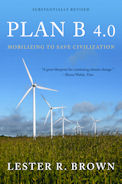 |
| |
CARS AND PEOPLE COMPETE FOR GRAIN www.earthpolicy.org/index.php?/book_bytes/2010/pb4ch02_ss6 By Lester R. Brown | ||
 At a time when excessive pressures on the earth's land and water resources are of growing concern, there is a massive new demand emerging for cropland to produce fuel for cars—one that threatens world food security. Although this situation had been developing for a few decades, it was not until Hurricane Katrina in 2005, when oil prices jumped above $60 a barrel and U.S. gasoline prices climbed to $3 a gallon, that the situation came into focus. Suddenly investments in U.S. corn-based ethanol distilleries became hugely profitable, unleashing an investment frenzy that will convert one fourth of the 2009 U.S. grain harvest into fuel for cars. At a time when excessive pressures on the earth's land and water resources are of growing concern, there is a massive new demand emerging for cropland to produce fuel for cars—one that threatens world food security. Although this situation had been developing for a few decades, it was not until Hurricane Katrina in 2005, when oil prices jumped above $60 a barrel and U.S. gasoline prices climbed to $3 a gallon, that the situation came into focus. Suddenly investments in U.S. corn-based ethanol distilleries became hugely profitable, unleashing an investment frenzy that will convert one fourth of the 2009 U.S. grain harvest into fuel for cars.The United States quickly came to dominate the crop-based production of fuel for cars. In 2005, it eclipsed Brazil, formerly the world's leading ethanol producer. In Europe, where the emphasis is on producing biodiesel, mostly from rapeseed, some 2.4 billion gallons were produced in 2009. To meet its biodiesel goal, the European Union, under cropland constraints, is increasingly turning to palm oil imported from Indonesia and Malaysia, a trend that depends on clearing rainforests for oil palm plantations. The price of grain is now tied to the price of oil. Historically the food and energy economies were separate, but now with the massive U.S. capacity to convert grain into ethanol, that is changing. In this new situation, when the price of oil climbs, the world price of grain moves up toward its oil-equivalent value. If the fuel value of grain exceeds its food value, the market will simply move the commodity into the energy economy. If the price of oil jumps to $100 a barrel, the price of grain will follow it upward. If oil goes to $200, grain will follow.
From 1990 to 2005, world grain consumption, driven largely by population growth and rising consumption of grain-based animal products, climbed by an average of 21 million tons per year. Then came the explosion in grain used in U.S. ethanol distilleries, which jumped from 54 million tons in 2006 to 95 million tons in 2008. This 41-million-ton jump doubled the annual growth in world demand for grain almost overnight, helping to triple world prices for wheat, rice, corn, and soybeans from mid-2006 to mid-2008. A World Bank analyst attributes 70 percent of the food price rise to this diversion of food to produce fuel for cars. Since then prices have subsided somewhat as a result of the global economic downturn, but they are still well above historical levels. From an agricultural vantage point, the world's appetite for crop-based fuels is insatiable. The grain required to fill an SUV's 25-gallon tank with ethanol just once will feed one person for a whole year. If the entire U.S. grain harvest were to be converted to ethanol, it would satisfy at most 18 percent of U.S. automotive fuel needs. Projections by Professors C. Ford Runge and Benjamin Senauer of the University of Minnesota in 2003 showed the number of hungry and malnourished people decreasing steadily to 2025. But their early 2007 update of these projections, which took into account the biofuel effect on world food prices, showed the number climbing rapidly in the years ahead. Millions of people living on the lower rungs of the global economic ladder, who are barely hanging on, are losing their grip and beginning to fall off. Since the budgets of international food aid agencies are set well in advance, a rise in food prices shrinks food assistance. The World Food Programme, which is now supplying emergency food aid to more than 30 countries, cut shipments as prices soared. Hunger is on the rise, with some 18,000 children dying each day from hunger and related illnesses. The emerging competition between the owners of the world's 910 million automobiles and the 2 billion poorest people is taking the world into uncharted territory. Suddenly the world is facing an epic moral and political issue: Should grain be used to fuel cars or feed people? The average income of the world's automobile owners is roughly $30,000 a year; the 2 billion poorest people earn on average less than $3,000 a year. The market says, let's fuel the cars. For every additional acre planted to corn to produce fuel, an acre of land must be cleared for cropping elsewhere. But there is little new land to be brought under the plow unless it comes from clearing tropical rainforests in the Amazon and Congo basins and in Indonesia or from clearing land in the Brazilian cerrado. Unfortunately, this has heavy environmental costs: a massive release of sequestered carbon, the loss of plant and animal species, and increased rainfall runoff and soil erosion. While it makes little sense to use food crops to fuel cars if it drives up food prices, there is the option of producing automotive fuel from fast-growing trees, switchgrass, prairie grass mixtures, or other cellulosic materials, which can be grown on wasteland. The technologies to convert these cellulosic materials into ethanol exist, but the cost of producing cellulosic ethanol is close to double that of grain-based ethanol. Whether it will ever be cost-competitive with ethanol from grain is unclear. There are alternatives to this grim scenario. The decision in May 2009 to raise U.S. auto fuel efficiency standards 40 percent by 2016 will reduce U.S. dependence on oil far more than converting the country's entire grain harvest into ethanol could. The next step is a comprehensive shift to gas-electric plug-in hybrid cars that can be recharged at night, allowing most short-distance driving—daily commuting and grocery shopping, for example-to be done with electricity. An even more fundamental need is to restructure transportation systems to provide far more options than the personal automobile. As the leading grain exporter and ethanol producer, the United States is in the driver's seat. It needs to make sure that efforts to reduce its heavy dependence on imported oil do not create a far more serious problem: chaos in the world food economy. The choice is between a future of rising world food prices, spreading hunger, and growing political instability and one of more stable food prices, sharply reduced dependence on oil, and much lower carbon emissions. # # # | ||
Etiquetas: Agrofuels, Biofuels, Earth Policy Institute, Lester Brown


0 Comentarios:
Publicar un comentario
Suscribirse a Comentarios de la entrada [Atom]
<< Página Principal